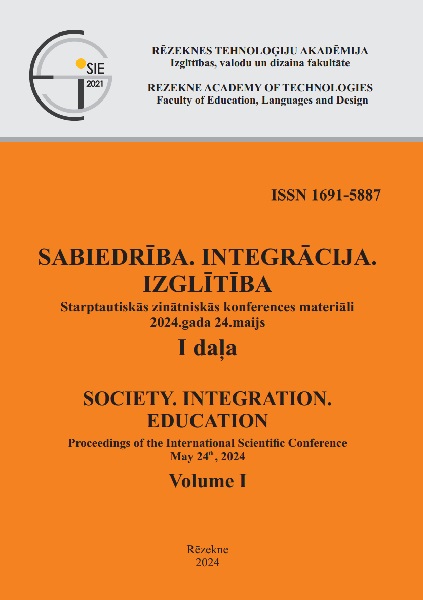BURNOUT SYNDROME IN SLOVAK TEACHERS IN RELATION TO SELECTED VARIABLES OF THE JOB DEMAND RESOURCES MODEL
DOI:
https://doi.org/10.17770/sie2024vol1.7870Keywords:
Burnout, Job Demand Resources Model, Risk Factors, Teachers, Well-beingAbstract
The aim of this paper is to explore and analyse the prevalence of risk factors (and factors) associated with burnout among Slovak teachers. The research sample consists of 274 respondents: teachers, school principals, and other pedagogical staff. We used the Job Demand Resources Model (JD-R model), which suggests that the interplay between job demands and resources determines the overall impact on employee well-being. Jobs with high demands and low resources are likely to lead to burnout and health issues, while jobs with high demands but sufficient resources can lead to positive outcomes such as increased motivation and job satisfaction. Investigating burnout in teachers is essential for promoting the well-being of educators, maintaining a high-quality education system, and ensuring positive outcomes for both teachers and learners. Based on the Job Demand Resources Model, this study aims to analyse the relationship between selected variables and burnout syndrome among Slovak teachers.
References
Bakker, A. B., & Demerouti, E. (2017). Job demands–resources theory: Taking stock and looking forward. Journal of Occupational Health Psychology, 22(3), 273–285.
Bakker, A. B., Demerouti, E., & Verbeke, W. (2004). Using the job demands‐resources model to predict burnout and performance. Human Resource Management, 43(1), 83–104. DOI: https://doi.org/10.1002/hrm.20004
Cansoy, R., Parlar, H., & Türkoğlu, M. (2020). A predictor of teachers’ psychological well-being: teacher self-efficacy. International Online Journal of Educational Sciences, 12(4). DOI: https://doi.org/10.15345/iojes.2020.04.003
Carroll, A., York, A., Fynes-Clinton, S., Sanders-O’Connor, E., Flynn, L., Bower, J., Forrest, K., & Ziaei, M. (2021). The downstream effects of Teacher Well-Being Programs: Improvements in teachers’ stress, cognition and Well-Being benefit their students. Frontiers in Psychology, 12. DOI: https://doi.org/10.3389/fpsyg.2021.689628
Hakanen, J., Bakker, A. B., & Schaufeli, W. B. (2006). Burnout and work engagement among teachers. Journal of School Psychology, 43(6), 495–513. DOI: https://doi.org/10.1016/j.jsp.2005.11.001
Hennelová, K., & Preisingerová, M. (2012). Syndróm vyhorenia u učiteľov gymnázií v kontexte demografických premenných. In Psychológia práce a organizácie 2012 (pp. 102–110). UPJŠ.
Huang, J., Wang, Y., & You, X. (2015). The Job Demands-Resources Model and Job Burnout: The Mediating role of personal resources. Current Psychology, 35(4), 562–569. DOI: https://doi.org/10.1007/s12144-015-9321-2
Nahrgang, J. D., Morgeson, F. P., & Hofmann, D. A. (2011). Safety at work: A meta-analytic investigation of the link between job demands, job resources, burnout, engagement, and safety outcomes. Journal of Applied Psychology, 96(1), 71–94. DOI: https://doi.org/10.1037/a0021484
Naidoo-Chetty, M., & Du Plessis, M. (2021). Job demands and job resources of academics in higher education. Frontiers in Psychology, 12. DOI: https://doi.org/10.3389/fpsyg.2021.631171
Pillay, H., Goddard, R., & Wilss, L. (2005). Well-being, burnout and competence: implications for teachers. Australian Journal of Teacher Education, 30(2). DOI: https://doi.org/10.14221/ajte.2005v30n2.3
Schaufeli, W., De Witte, H., & Desart, S. (2020). Manual Burnout Assessment Tool (BAT) – Version 2.0. Belgium: Unpublished internal report.
Roos, B. H., & Borkoski, C. (2021). Attending to the Teacher in the Teaching: Prioritizing Faculty Well-Being. Perspectives of the ASHA Special Interest Groups, 6(4), 831–840.
Ross, S., Romer, N., & Horner, R. (2011). Teacher well-being and the implementation of school-wide positive behavior interventions and supports. Journal of Positive Behavior Interventions, 14(2), 118-128.
Žitniaková Gurgová, B., & Behúňová, L. (2017). Stresory a syndróm vyhorenia v práci učiteľa ZŠ. Pedagogika.sk, 8(2), 92–108. Retrieved from: http://www.casopispedagogika.sk/rocnik-8/cislo-2/studia-gurgova.pdf






